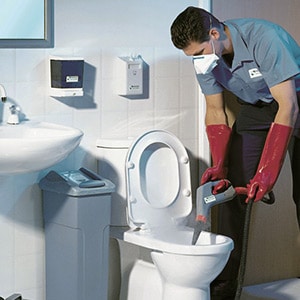In the 21st century, one of the biggest issues of our time is the efficient use of natural resources. Water consumption and conservation are at the heart of sustainability conversations.
Waterless urinals are the answer to the extravagant use of water due to flushing.
In appearance, waterless urinals look like flushing urinals. The main difference is the absent flush valve that should sit right above the urinal. This is because waterless urinals have no need for water and thus no need for piping.
They are built with a vertical trap design that has a cylinder filled with liquid sealant. It sits atop the drain area of the urinal. Urine goes through the cylinder and sealant, draining into the waste line, and passes through the barrier layer.
The dry urinal surface inhibits bacteria growth and odour, making the waterless urinal easier to clean and maintain. The lack of water also prevents rust buildup, unlike a conventional flushing urinal.
Why Waterless Urinals Are Great
There’s been a surge in installing waterless urinals, especially in recent years where many states have raised water rates. The higher rates come from upgraded facilities or the rising costs of gathering, treating, delivering and removing water.
This has inspired many office blocks, schools and hotels to install waterless urinals. They look a lot like traditional urinals but don’t need any water. This saves institutions thousands of dollars in annual water bills.
-
Waterless Urinals Are Odour Free
Odours are not an issue when it comes to waterless urinals. The cause of odour in flush urinals is when urea and water react. In the absence of water, no reaction takes place and no odour will exist. Furthermore, the sealant liquid prevents any odour from coming back into the washroom atmosphere.
-
Cost Savings on Environment and Water
How much water do waterless urinals save? All of it, as they don’t need any water at all to work. The only water you may need is about 20 litres during periodical maintenance to flush down the drain line. This drain line flush prevents the buildup of limescale.
In a building with a few dozen male employees using the flushing urinal about three times a day, the estimated water consumption of a single flush urinal is 75,000 to 170,000 litres of water annually. The average toilet uses about one to three gallons (3.17-11.3 litres) of water for each flush. Newer models tend to use less so the exact cost saving for your building depends on the flush units you are replacing.
Waterless urinals pay for themselves in water bill savings alone in the first one to three years. All the water used by flush urinals costs money depending on the metered rates for the municipality and the level of use. Individual waterless units cost around $250 to $500 per urinal.
-
Cost Savings on Installation and Maintenance Installation
Waterless urinals are less prone to malfunctioning due to the absence of moving parts. They are easy to clean and offer savings on maintenance. The only maintenance costs are the replacement of sealant liquid and cartridges every three to six months.
These maintenance costs savings come as a result of the following:
- There are no mechanical parts to buy or repair.
- There are reduced opportunities for vandalism since flush mechanisms, commonly stolen items, are absent.
- The waterless urinals are less costly to buy and install compared to traditional urinals.
- No special plumbing is required since they drain into the standard two-inch drain.
-
Waterless Urinals Allow Urine Reuse for Ecological Benefits
Waterless urinals have unexpected ecological benefits. You can collect pure and undiluted urine for reuse as fertiliser in urban farming after proper treatment and storage. If your facility has a high usage urinal, this can be an alternative revenue source for your building.
-
Waterless Urinals Give You Green Building Rating Points
As a great marketing tool to eco-conscious clients, waterless urinals can earn you up to six points on LEED, or an equivalent green building certification in your country. This creates a positive image for your brand and building, increasing your reputation and eventual profits. Consumers do business with people and companies they like.
How to Care for Waterless Urinals
-
Use Proper Cleaning Agents

Alsco’s Deep Clean Services eliminates all mould, mildew and fungi.
Despite your best efforts, regular cleaning always leaves something behind. You need occasional systematic cleaning to reach difficult areas or clean any build-up. Plan for thorough cleaning to keep your buildings and offices clean with healthy employees.
Alsco’s deep cleaning service offers what you need. Our systems rely on powerful chemicals and high-tech equipment. Both have been designed for the complete elimination of dirt, filth, uric acid build-up and germs. All that is left is a spotlessly clean, sanitary and healthy washroom.
The best way to remove dirt and germs is to find something that eats it. That’s precisely what Alsco offers. Our amazing biological solution is packed with harmless “bugs” that eat bacteria and other germs without damaging the washroom surfaces.
While toxic chemicals are not environmentally friendly, they are also only a one-time solution. With our “hungry microbes,” those horrible, smelly build-ups are a thing of the past. The effects last longer and the environment is saved.
Alsco uses the bio solution to clean your washrooms. We also leave blocks to maintain hygiene. Our representatives come regularly to clean and replace the solution or blocks.
-
Train Maintenance Staff on How to Handle Waterless Urinals
Regardless of the slight variations that different manufacturers use, cleaning a waterless urinal follows the same process. Here are the important steps that your staff should follow:
- Put on gloves (and goggles) to clean any restroom.
- Start by removing any foreign objects in the urinal. The trap is designed to prevent larger objects from entering the drain area.
- Avoid abrasive cleaners, towels, or brushes.
- Mist urinal surfaces with a neutral or all-purpose cleaner.
- Allow for dwell time (if indicated by the chemical manufacturer).
- Wipe clean with a soft sponge or a cleaning cloth.
- Dry the surfaces with a soft cloth.
- Do not pour excess or soiled water down the waterless urinal trap, as it can flush the sealant out of the trap insert.
-
Never Put Water Down Waterless Urinals
Putting water down a waterless urinal can spoil it. They are made to function without water and are not built to handle it. Instruct your staff to avoid pouring water or cleaning solution down the urinal.
In the event water is poured down a waterless urinal, the calcium in the water will react with uric acid to create limescale deposits. Traditional urinals can counteract this effect because of the continuous flushing. In waterless urinals, all it takes is a small amount of water for a limescale reaction to occur. Without flushing, the limescale builds up and blocks the urinal.
What Can You Do?
If you’re investing in waterless urinals, it’s critical that you invest in training and education. If you clean your urinals correctly, they won’t smell. With all the great benefits associated, you will wonder what took you so long to invest in a waterless urinal.
Since cleaning waterless urinals is different from traditional urinals, ensure your cleaners understand this. Use the correct cleaning agent for daily maintenance. A bio cleaner is a sustainable and thorough solution for cleaning waterless urinals. Alsco NZ provides a top of the line bio-cleaner at an affordable monthly fee.
Alternatively, use a cleaning partner that understands public washrooms and how to clean different units. Partners like Alsco NZ are great for the occasional deep cleaning to reach the corners where dirt builds up.
If you have old, stubborn stains and uric acid build-ups, they are almost impossible to get rid of. Almost! With Alsco Deep Clean, their four-step process eliminates all sorts of dirt, grime and filth. It is effective on toilets, showers and other washroom elements.
With some planning, maintaining a hygienic and functional restroom is within your reach. Get reliable partners like Alsco NZ so you can focus on what you do best.
Photo: Creative Commons


